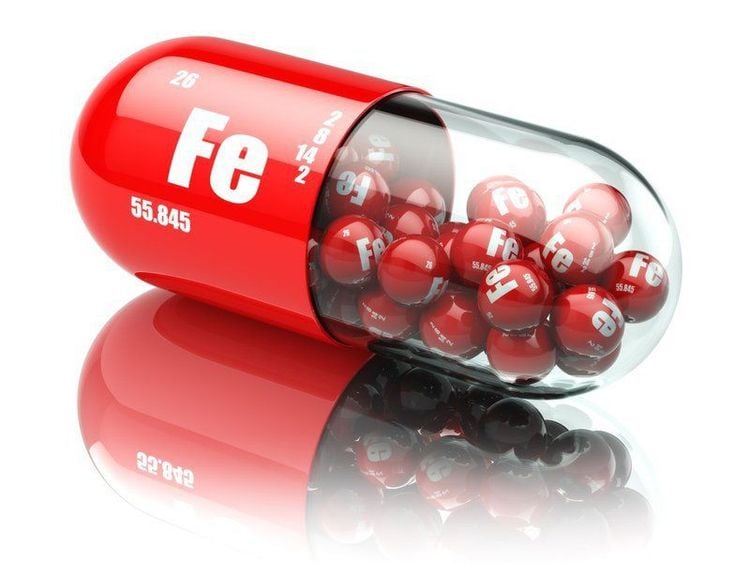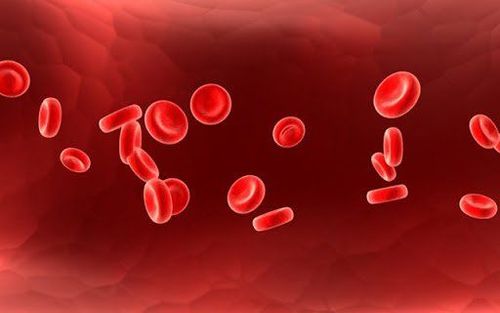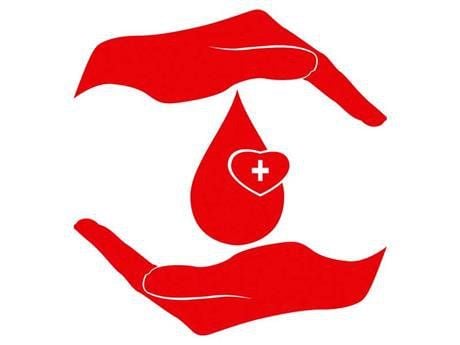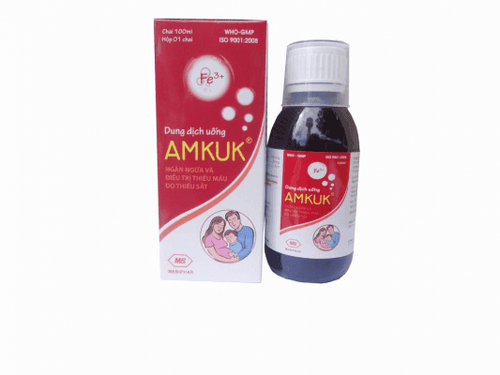This is an automatically translated article.
Types of anemia are often distinguished by their characteristics and causes. It is possible that iron deficiency anemia can also be low red blood cell anemia. To better understand the causes of anemia, please refer to the 4 common types of anemia below.
1. Iron deficiency anemia
Iron is one of the indispensable trace elements in our daily meals. This is no longer just a metal used to make working tools, but it has become a source of nutrients that the body needs to be provided. When enough iron is added, the body will produce the protein hemoglobin, which helps oxygen be carried by red blood cells to the functional organs.
Iron is added and stored so that the agents that destroy them can return to the bone marrow and regenerate. However, some daily activities of the body will consume iron irreversibly. So you need to get a certain amount of iron from food to ensure enough red blood cells. That amount of iron is very small, but it is affected by each body's ability to absorb it.
Pregnancy or human development milestones is when the body needs more iron. Therefore, it is also a subjective cause of iron deficiency anemia. Moreover, because women undergo monthly menstruation, they also have an increased risk of anemia than men.
Others are iron-deficient anemia due to trauma or surgery. However, we often find out when things have gone badly. The body stores iron in the bone marrow in case it needs it. If iron deficiency anemia continuously occurs, the reserve will not be enough and then you will find out that you have iron deficiency.
So who is at risk of iron-deficiency anemia that needs attention? Babies and young children are the subjects we are most susceptible to being subjective. Most babies will get their nutrition from breast milk and be nourished in the womb. However, if the mother is not provided with adequate nutrition, the baby will be born with many defects that are difficult to overcome. In addition, in the neonatal period, babies develop quite quickly physically and physically, so the amount of iron the body needs is also more. Another problem is that because babies are exclusively breastfed, it is difficult for the baby to absorb more iron if the mother has diseases that affect the synthesis of iron in milk. Infants born prematurely with low birth weight or whose mothers are breastfed without formula are at an increased risk of iron deficiency.
Studies have shown that iron plays a role in human brain and intellectual development. Therefore, pregnant women, lactating women, infants and young people need to pay attention to the amount of iron in their daily nutrition. Not only the above subjects, people with chronic diseases are also at high risk of iron deficiency.
In a vegan or vegetarian diet, the food variety is somewhat limited. While they provide nutritional health benefits, they are not good for everyone. If your body does not absorb iron from plants well, there is an increased risk of fatigue when switching to a vegetarian diet. Therefore, a reasonable diet for vegetarians and vegans is always quite complicated.
When you experience iron deficiency anemia, pay attention to add some iron-rich foods to balance it. Animal sources of iron can be found in seafood, lean red meat, or animal organs. With plant-based iron you will easily find it in dark green leafy vegetables or some nuts or lentils.

Sắt đóng vai trò trong phát triển não bộ và trí tuệ của con người
2. Pernicious anemia
Same is anemia due to nutritional imbalance but pernicious anemia is somewhat more dangerous than iron deficiency. Pernicious anemia occurs when you don't get enough of the vitamin B12 your body needs. You can get this vitamin through bread, cereal and a soy product. They will be absorbed and partially stored in the liver to supply when the body is lacking.
There have been many cases of chronic anemia leading to death, so it is so named so that the patient is not subjective to health. The cause of this syndrome can be due to the body not absorbing vitamins or problems in the small intestine. When you are folate deficient, your risk of vitamin B12 deficiency also increases.
Newborns rarely have this condition unless it's due to a genetic predisposition. Most patients with pernicious anemia do not absorb vitamin B12 or have cells that break down this vitamin structure. Intestinal infections are also one of the dangerous diseases leading to iron deficiency and weakening of the body's immune system.
Signs of pernicious anemia usually develop slowly. The obvious sign is that the body is tired and dizzy. In addition, your body temperature will drop and you will often feel cold. Sometimes pernicious anemia also affects the heart and leads to heart failure.
If the loss of vitamin B12 is prolonged, you may experience nerve damage. This leads to tingling or numbness in the limbs. Worse, you have difficulty moving and your temper becomes short-tempered. When the nervous system is damaged, your mind and memory are impaired. You are also at risk for psychological problems such as psychosis or depression.
Pernicious anemia can be treated with vitamin B12 supplements or changes to a nutritionally balanced diet. However, to get the best results, you should consult a specialist first to ensure safety for your health.
3. Anemia due to not producing enough needed
Low red blood cell anemia is a type of aplastic anemia that leads to a decrease in the number of red blood cells. The lifespan of red blood cells is usually about 120 days. Meanwhile, platelets can live up to 6 days. At the same time, there are countless types of white blood cells with different lifespans coexisting. Therefore, the body always needs new, nutritious blood cells to nourish the functional organs.
When your bone marrow is damaged, aplastic anemia is more likely to occur. Then the body is not able to make red and white blood cells to meet the body's needs. Although this is a rare disease, its risk of death is quite high. To date, studies have not found the exact cause of aplastic anemia.
Some cases of aplastic anemia have been linked to a blood disorder called paroxysmal nocturnal hemoglobinuria. However, it is short-term aplastic anemia. The causes of long-term aplastic anemia are currently unknown.
All ages are at risk for aplastic anemia. However, it is most common in adolescents and the elderly. When you have low platelets, it will cause bleeding, or bruising on the skin. Some others will have hemorrhagic nodules, nosebleeds and bleeding gums ... From those symptoms you can detect and get help from a doctor.
Aplastic anemia can be treated with medication, blood transfusion, or blood cell transplant... To choose the most effective method, your doctor will consider your family medical history. Based on the medical records of the members, it is possible to accurately diagnose the cause of the disease.

Thiếu máu hồng cầu thấp là một kiểu thiếu máu bất sản
4. Anemia due to hemolytic disease
Although the survival time of red blood cells is not low, at the end of the cycle they will face the risk of breaking down. Although the body always regenerates and produces new red blood cells, when cells are eliminated quickly and cannot regenerate, it will lead to hemolysis.
Hemolytic anemia occurs when the bone marrow cannot make enough red blood cells the body needs. Causes can be due to autoimmune reactions, physical damage, body exposure to toxic chemicals, ... This disease can be passed down through generations. In addition, this disease affects all subjects, not just anyone. Therefore, you need to pay attention when you have signs of fatigue and dizziness, then ask a specialist to intervene.
Characteristic signs of hemolytic anemia are jaundice, upper abdominal pain, red or brown urine, enlarged spleen, chills. To diagnose the disease, the doctor will check for genetic factors before performing the test. There are many testing methods such as: Blood embryo, hemoglobin electrophoresis, blood test... In addition, liver and marrow tests can be performed...
Treatment of hemolytic anemia depends on in different types of hemolytic anemia. Based on factors such as age, genetics, etc., the doctor will assess the severity of the disease. The goal of this treatment is to minimize the destruction of red blood cells, increase the amount of RBC... Most importantly, maintain a healthy lifestyle.
Above are common types of anemia for your reference. Based on the mild symptoms, you should quickly provide nutrition and exercise to avoid leading to severe anemia.
Vinmec International General Hospital is one of the hospitals that not only ensures professional quality with a team of leading medical doctors, modern equipment and technology, but also stands out for its examination and consultation services. comprehensive and professional medical consultation and treatment; civilized, polite, safe and sterile medical examination and treatment space.
Please dial HOTLINE for more information or register for an appointment HERE. Download MyVinmec app to make appointments faster and to manage your bookings easily.
References: nhlbi.nih.gov













